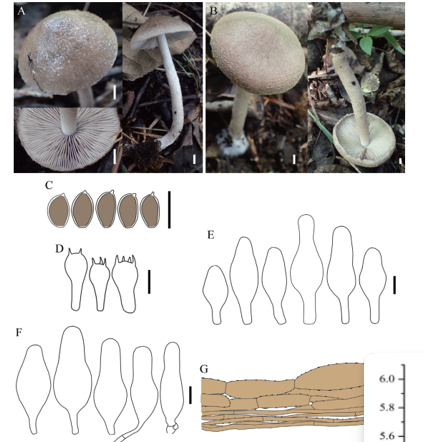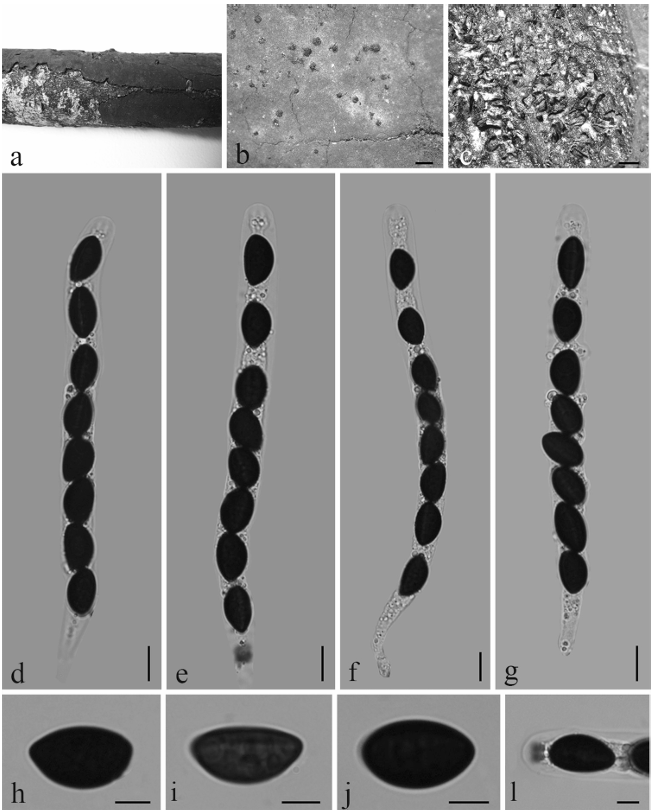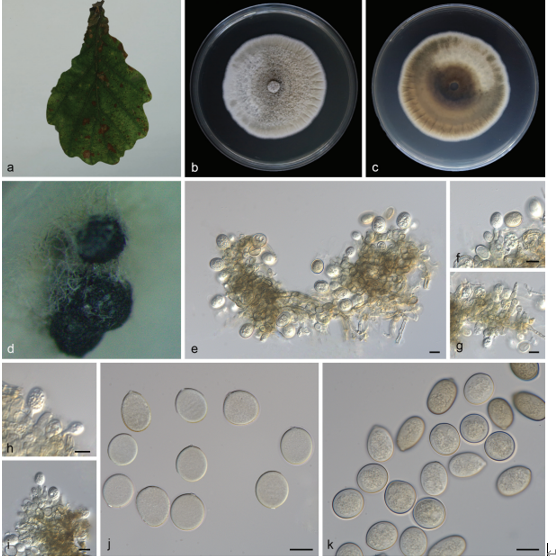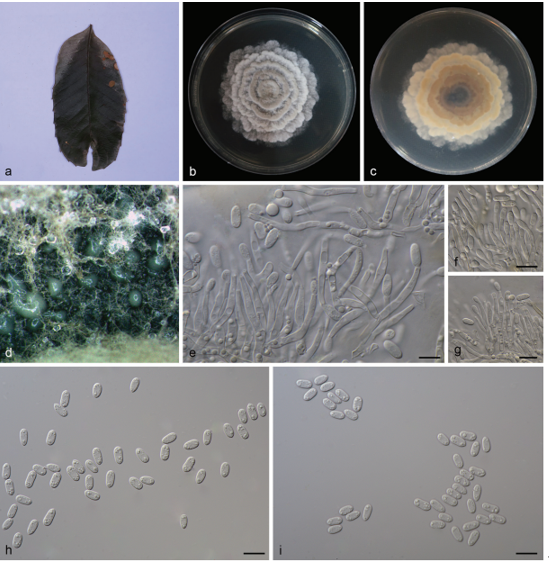Tomentella parvispora H.S. Yuan & Y.C. Dai 2020
Index Fungorum number: IF555769; Facesoffungi number: FoF 05640
Holotype: CHINA, Liaoning Province, Xifeng County, Binglashan National Forest Park, on rotten angiosperm branch, 2 August 2016, Yuan 11144 (IFP 019317, holotype); Huanren County, Laotudingzi Nature Reserve, on rotten angiosperm wood debris, 20 October 2015, Yuan 10645; 21 October 2015, Yuan 10703; Qingyuan County, Qingyuan Experimental Station of Forest Ecology, on rotten angiosperm wood debris, 3 August 2016, Yuan 11196 (IFP 019318), 11162, 11176, 11181, 11182, 11185, 11188, 11192, 11193, 11214 & 11215; on rotten angiosperm branch, Yuan 11179 & 11220.
Morphological description
Basidiocarps annual, resupinate, adherent to the substrate, pelliculose, without odour or taste when fresh, up to 0.1 mm thick, continuous. Hymenophoral surface smooth to indistinctly granulose, yellowish brown (5E5–5F8) and darker than subiculum when dry. Sterile margin often indeterminate, byssoid, light brown (5D5–8). Subiculum mostly pale yellowish brown. Rhizomorphs present in subiculum, 10–20 μm diam; rhizomorphic surface more or less smooth; hyphae in rhizomorph monomitic, undifferentiated, of type B, compactly arranged and of uniform; single hyphae clamped, thick-walled, unbranched, 1.5–2.5 μm diam, pale orange in KOH, cyanophilous, inamyloid. Subicular hyphae monomitic; generative hyphae clamped, thick-walled, occasionally branched, 4.5–6 μm diam, occasionally collapsed, without encrustation, pale orange in KOH, cyanophilous, inamyloid. Subhymenial hyphae clamped, thin- to slightly thick-walled, occasionally branched, 3–6 μm diam; hyphal cells more or less uniform, pale orange in KOH, cyanophilous, inamyloid. Cystidia absent. Basidia 20–40 μm long and 6–9 μm diam at apex, 5–7 μm at base, with a clamp connection at base, clavate, stalked, sinuous, without transverse septa, pale orange in KOH, yellowish brown in distilled water, 4-sterigmate; sterigmata 2–5 μm, 1–2 μm diam at base. Basidiospores thick-walled, (5.5–)5.7–6.7(–7) × (5–) 5.3–6.4(–7) μm, L = 6.14 μm, W = 5.74 μm, Q = 1.04–1.09 (n = 60/2), irregularly globose or lobed in frontal view and ellipsoid in lateral view, echinulate, pale brown in KOH, pale brown in distilled water, cyanophilous, inamyloid; echinuli usually grouped in 2 or more, up to 0.6 μm long.
Habitat: On rotten angiosperm branch.
Distribution: In China.
GenBank Accession: ITS: KY686226, KY686227; LSU: MK446405, MK446406.
Notes: Tomentella minispora Yorou is similar to T. parvispora by having continuous basidiocarps adherent to the substrate, clamped, thin- to slightly thick-walled subhymenial hyphae, the absence of cystidia, and small, echinulate basdiospores with echinuli of approximately equal size. However, the former species has an absence of rhizomorphs, short inflated externally encrusted subhymenial hyphae and a farinaceous basidiocarp margin (Yorou et al. 2013). T. olivacea resembles T. parvispora by having pelliculose and continuous basidiocarps, a smooth and granulose hymenophore with byssoid sterile margin, the presence of rhizomorphs, clamped and thick-walled hyphae without encrustation and irregular, echinulate basidiospores. However, it differs from T. parvispora by having olive brown basidiocarps and bigger basidiospores (6.5–7.9 × 5.5–6.8 μm).
Reference: Hai‑Sheng Yuan1,2· Xu Lu1,2 · Yu‑Cheng Dai3 ·
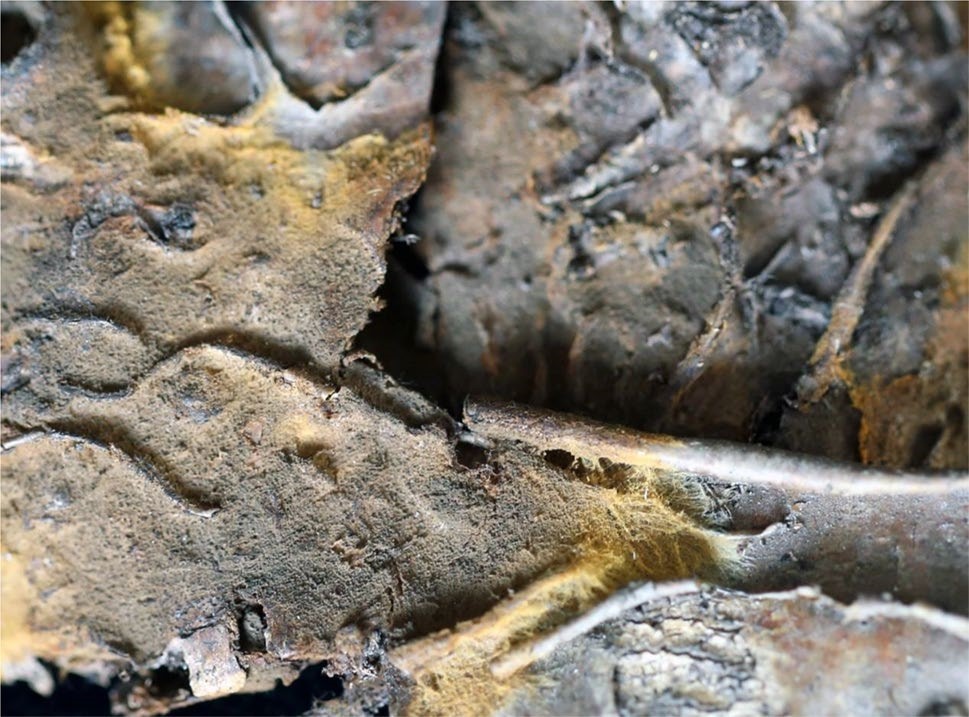
A basidiocarp of Tomentella parvispora (IFP 019317, holotype)


